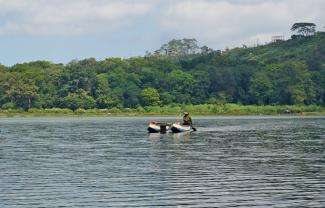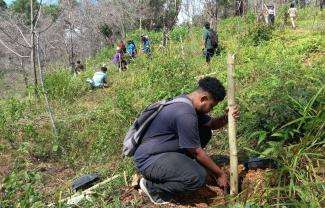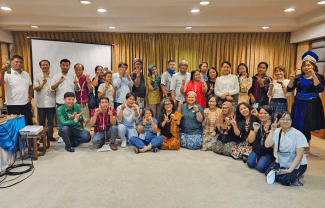Located in Bali’s Buleleng Regency, Alas Mertajati is a water catchment area that provides drinking water and supports traditional irrigation systems (subak) throughout the island. Together with Lake Tamblingan, Alas Mertajati fulfils almost a third of Bali’s water needs. But for the Indigenous People who have cared for this area over many centuries, its true value goes far beyond practical importance.
"Alas Mertajati is integral to the Dalem Tamblingan Indigenous People," explains Bili, a young man from the Adat Dalem Tamblingan (ADT) Indigenous community who is committed to protecting forests and lakes in the Alas Mertajati area. The ADT consider Alas Mertajati and Lake Tamblingan to be their ancestral home and the wellspring of their traditional way of life.
According to local legend, this location was first settled the 10th century by a man named Dewa Behem, who reportedly had the ability to heal the sick. On one occasion, various residents of Alas Mertajati reportedly fell ill. Dewa Behem then went to a pond in the nearby area, where he collected water using a sangku (a container for holy water). This water was then purified through prayer and sprinkled on all those who were sick. Those blessed in this way were quickly healed. Thereafter, the pond was called ‘Tamba Eling’, meaning ‘source of medicinal water’. Over time, this name was shortened to Tamba-Ling and finally Tamblingan.
At the end of the 14th century, the community living in and around Alas Mertajati decided to leave, in order to keep the lake clean and the water catchment area free from human activity. They declared it to be a sacred place, as it was a source of life and healing. This group travelled to Indu Gobed (now called Gobleg) and the villages of Munduk, Gesing and Umejero. These four locations collectively became known as ‘Catur Desa Adat Dalem Tamblingan’.
Ever since that time, Alas Mertajati and Lake Tamblingan have been considered sacred – it is forbidden for anyone to live permanently within these areas. An indication of the region’s spiritual significance is the many interrelated temples and shrines (17 in total) scattered in and around the forest and lake.
"Residents regularly perform rituals here as a form of gratitude for Alas Mertajati's providence as a water source," explains Putu Ardana, who is chair of the Baga Raksa Alas Mertajati organisation (commonly known as ‘BRASTI’). He confirms the ADT are often referred to as followers of Vishnu Vaisnawa or adherents of Piagem Gama Tirta, as many of their rituals and spiritual practices are centred around water (tirta).
Water as the Source of Life
The ADT Indigenous People are committed to protecting and securing this water source, which they see as vital to many aspects of their daily and spiritual lives. Various activities are held regularly to protect the area from damage.
Water from Alas Mertajati is the lifeblood of Subak Jatiluwih; an area of traditional farmland that was officially designated as a World Heritage Site by UNESCO in June 2012. "Alas Mertajati acts as a water supplier for subak in Jatiluwih, they get their water from here," explains Putu. "People from Jatiluwih often pray here to give thanks and show their respect to the gods of Alas Mertajati."
These ancient ties between Indigenous Peoples and nature were disrupted when the Bali Natural Resources Conservation Agency (KSDA) decided to designate the Alas Mertajati area as a Nature Tourism Park. Based on Minister of Forestry Decree No. 144/Kpts-II/1996, an area of 1,336.5 hectares was included under the management of the Bali KSDA Office. This decree opened the door to various investors and private enterprises, who proceeded to carry out tourism activities with little or no regulation.
As a result, Alas Mertajati has experienced significant environmental degradation. This is marked by a decline in the diversity of flora and fauna. "Animals and plants are disappearing,” says Putu, who fears the sanctity of the area has been compromised. “Even though it still looks beautiful here, there are barren, empty areas inside." After thousands of years, this sacred water source is now under serious threat.
Working Together to Restore the Glory of Water
In response to these concerns, the Dalem Tamblingan Indigenous People are advocating with the government for customary forest status, so stewardship of Alas Mertajati can be returned to the local Indigenous People who have safely guarded it for centuries.
Customary forests are areas that fall under the jurisdiction of local tribal laws (adat). They are managed by people with strong ancestral ties to the land, having lived in these geographic areas for generations. This connection engenders strong relationships with the environment, while also being synonymous with traditional value systems that underpin economic, political, social and legal institutions and processes.
In order for land rights in customary forests to be officially recognised by the Ministry of Environment and Forestry of the Republic of Indonesia, a number of requirements must first be met. This begins with the recognition of Indigenous groups, whose customary territories need to be demonstrated on a valid participatory map.
With support from DGM-I and in collaboration with the Wisnu Foundation, Samdhana has been working to help the Dalem Tambligan Indigenous People to formally apply for recognition of their customary forest management rights, so they can continue to protect and venerate the sacred waters of Alas Mertajati. This process includes data collection spanning the history of the community, its institutions and its customary laws and territories. It also identifies whether the community is still collecting forest products.
Working in collaboration with the Wisnu Foundation, the Dalem Tamblingan Indigenous People have been compiling data covering boundaries, forest inventory, zoning and mapping, as well as long- and short-term forest management plans. This has been carried out by a team of 15 people, comprising 11 men and four women, along with two assistants from the Wisnu Foundation. In addition to mapping the forest, this group has been verifying data on the flora and fauna in Alas Mertajati; all sample data has now been collected and compiled into a comprehensive map.
In spite of many obstacles, this difficult path has resulted in a document being submitted to the Minister of Environment and Forestry of the Republic of Indonesia, which will hopefully result in legal recognition of Alas Mertajati as a customary forest. The ADT are currently waiting for a response to their application from the Ministry of Environment and Forestry.
In the meantime, they continue to protect and conserve the area in an informal capacity. They regularly conduct clean-up operations at Alas Mertajati and around Tamblingan Lake to keep these places free of rubbish, while also making sure no buildings are erected or activities held that could by damaging. In addition, the ADT routinely hold sacred rituals at the site, giving thanks to Alas Mertajati for the life-giving water it provides.
"We have conveyed to the central government that investment in Alas Mertajati is not in accordance with the values we hold dear,” explains Putu. “If necessary, we will defend it with body and soul.” Samdhana continues to support the Dalem Tamblingan Indigenous People in their fight, by providing grants, direct capacity development, facilitation and policy development for legal recognition of their land rights.




